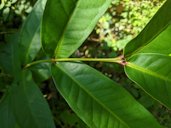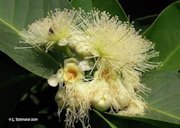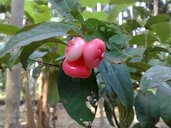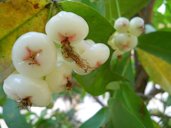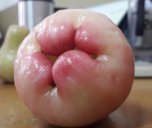| Wax Jambu - Syzygium samarangense | |||||||||||||||||||||
|---|---|---|---|---|---|---|---|---|---|---|---|---|---|---|---|---|---|---|---|---|---|
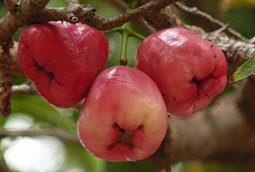 Fig. 1  Wax Apple, Syzygium samarangense, Java central, Indonésie 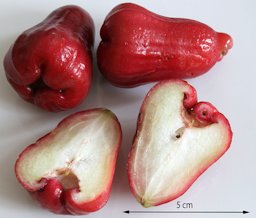 Fig. 2  Wax apples/java apples (S. samarangense), bought at Dong Xuan Center in Berlin 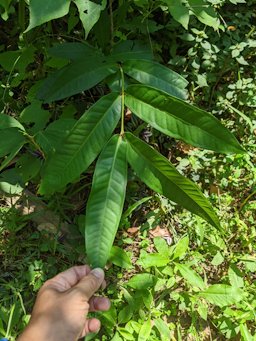 Fig. 3  Wax Apple, S. samarangense, Taichung, Taiwan 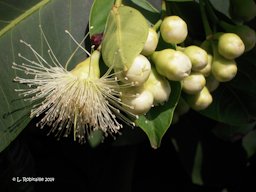 Fig. 7  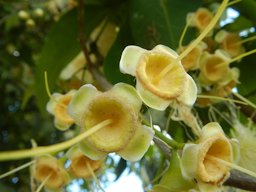 Fig. 8  S. samarangense in the Philippines 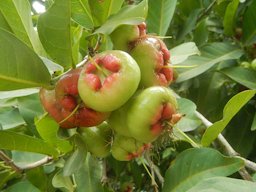 Fig. 11  Sipat Plaridel, Bulacan, Philippine, during enhanced community quarantine 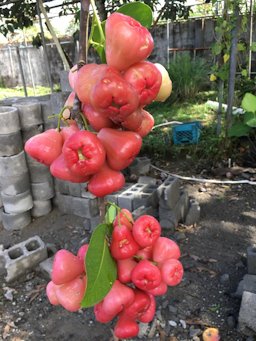 Fig. 12  Wax Apple S. samarangense, El Empalme, Panama 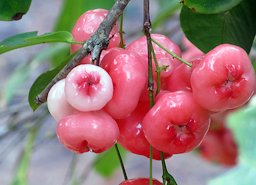 Fig. 13  മലയാളം: കേരളത്തിലെ നാട്ടിന്പുറങ്ങളില് കണ്ടുവരുന്ന രുചികരമായ ഒരു ഫലം 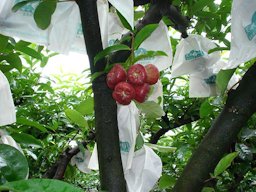 Fig. 14  Lainwu (wax apple) bagged on the tree 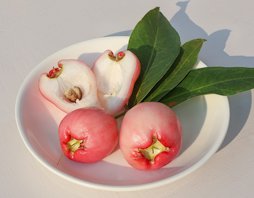 Fig. 19  S.samarangense (Java apple), edible fruit on a plate, with a cut cross section 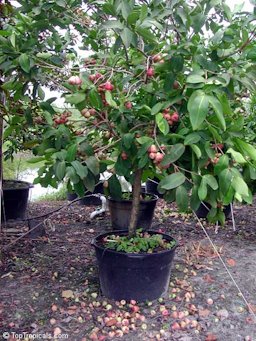 Fig. 20  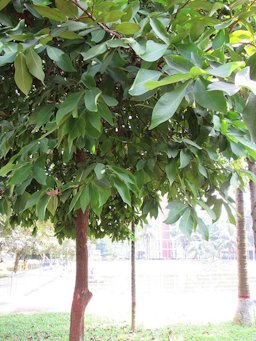 Fig. 21  S. samarangense (rose apple) tree in RDA, Bogra, Bangladesh 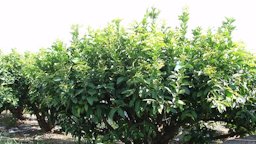 Fig. 22  Wax apple orchard, Taiwan 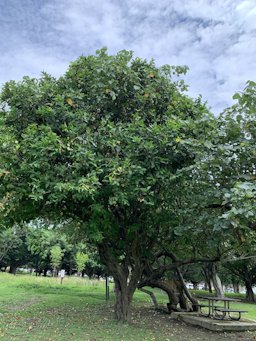 Fig. 23  Wax Apple, S. samarangense, Taipei, Taiwan 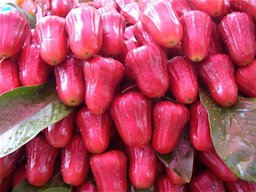 Fig. 24  Rose apple/java apple/wax apple (S. samarangense) - pink variety 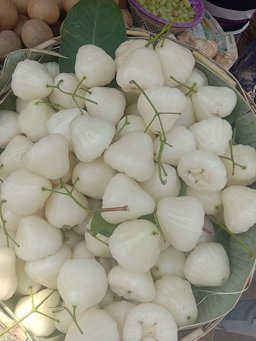 Fig. 25  Fruits of S. samarangense at a street-side shop in Jagadishpur Hat, West Bengal, India 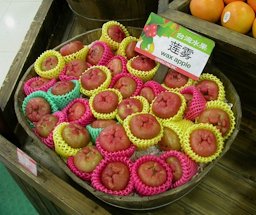 Fig. 26  Taiwan fruits, Grand Pacific, Beijing, China |
Scientific
name Syzygium samarangense (Blume) Merr. & L.M. Perry Common names English: Java apple, Java rose aple, samarang rose apple, water apple, wax jambu, wax apple; Chinese: jin shan pu tao, lian wu, nan yang pu tao (Hong Kong), yang pu tao; Dutch: curacaose appel; French: pomme d’eau de formose, pomme de Java; German: Java-apfel; Hindi: amrool, jamrool, jamrul, jumrool; Japanese: renbu; Malay: jambu air mawar, jambu ayer rhio, jambu klampok, jambu semarang (Indonesia); Nepalese: ambake (as Eugenia formosa); Sinhalese: pini jambu; Spanish: cajuil de solim (Dominican Rep.), cashu di Surinam, makopa (Costa Rica), manzana de Java, maran de Curacao (Panama); Tagalog: makopa; Thai: chom phuu (as S. javanicum), chom phuu kaem maem, chomphuu kao, chomphuu khieo (chomphuu kio), chomphuu nak; Vietnamese: man, roi 6 Synonyms Eugenia javanica Lam., E. javanica var. parviflora Craib, E. javanica var. roxburghiana Duthie, E. samarangensis (Blume) O.Berg, Jambosa javanica (Lam.) K.Schum. & Lauterb., J. samarangensis (Blume) DC., Myrtus javanica (Lam.) Blume, M. samarangensis Blume, S. samarangense var. parviflorum (Craib) Chantaran. & J.Parn. 1 Family Myrtaceae (myrtle family) Origin Native to Malaysia and adjacent Southeast Asia regions 8 USDA hardiness zones 10-11 Uses Fruit; landscape specimen Height 16-50 ft (5-15 m) 2,6 Spread Wide, irregular canopy Crown Open, widespreading crown 2 Growth rate Very fast Trunk/bark/branches Short; crooked trunk; often branched near the base; pinkish-grey, flaking bark 6 Pruning requirement Required to keep under control and ease of harvest Leaves Evergreen; opposite, elliptic/elliptic-oblong, coriaceous, w/thin margin; pellucid dotted; strongly aromatic when bruised 4 Flowers Terminal and in axils of fallen leaves; 3-30-flowered 4 Fruit Berry; broadly pyriform; crowned by the fleshy calyx w/incurved lobes; light red to white; flesh crispy white; spongy core; juicy; aromatic 4 Season May-Sept. and Nov.-March Light requirement Light shade to full sun Soil tolerances The soil must be fertile, or the crops will be small and the fruit quality poor 2 Drought tolerance Moderate Aerosol salt tolerance Unknown Soil salt tolerance Unknown Cold tolerance Will not tolerate below 44 °F (7 °C) Plant spacing 15-20 ft (4.6-6 m) Roots Not a problem Invasive potential * None reported Pest resistance Unknown Known hazard None Reading Material Java Apple, Fruits of Warm Climates Syzygium samarangense, World Agroforestry Center Syzygium samarangense, PROSEA Foundation The common names given to Syzygium species can be confusing, because they are applied to different species. S. samarangense is sometimes also called water apple, which is actually the common name for S. aqueum. The genus comprises approximately 1,100 species native to Africa, Asia, Australia, and the southern Pacific. Several species like the rose apple (S. jambos) and the Malay apple (S. malaccense) are cultivated as fruit trees or ornamentals. In Southeast Asia, various varieties differing in growth habit and fruit characteristics are cultivated commercially. The most popular varieties such as ‘Kong Wan Pink’ and ‘Delima’ have pink fruits with sweet white flesh. 8 Not to be confused with Malay apple (Syzygium malaccense) which is known as the pommerac in Trinidad and Tobago. Origin It is a native of South East Asia and is distributed in the Andaman Islands and is also grown in parts of south India and West Bengal. Java rose apple is widely grown throughout the tropics. These often occur in home gardens with limited commercial production in Malaysia, Australia and Central and South America. 7 The Syzygium samarangense 'Srinark' from Thailand was introduced to Florida in 1960 by Bill Whitman. 5 Description This free-branching, medium sized tree similar to Malay Apple, is somewhat hardier. It also has large and wide glossy leaves and a waxy-looking fruit, probably hence the common name. The flowers and resulting fruit are not limited to the axils of the leaves and can appear on nearly any point on the surface of the trunk and branches. 3 The tree, 16 to 50 ft (5-15 m) tall, has a short trunk 10 to 12 in (25-30 cm) thick, and open, widespreading crown, and pinkish-gray, flaking bark. The waxy fruit, usually light-red, sometimes greenish-white or cream-colored is pear-shaped, narrow at the base, very broad, flattened, indented and adorned with the 4 fleshy calyx lobes at the apex; 1 1/3 to 2 in. (3.4-5 cm) long, 1 3/4 to 2 1/8 in. (4.5-5.4 cm) wide. The skin is very thin, the flesh white, spongy, dry to juicy, subacid and very bland in flavor. There may be 1 or 2 somewhat rounded seeds 3/16 to 5/16 in (0.5-0.8 cm) wide, or none. 2 Leaves The opposite leaves are nearly sessile, elliptic-oblong, rounded or slightly cordate at the base; yellowish to dark bluish-green; 4 to 10 in. (10-25 cm) long and 2 to 4 3/4 in. (5-12 cm) wide; very aromatic when crushed. 2
Fig. 4,5,6. Wax Apple, S. samarangense, Taichung, Taiwan Flowers Flowers, borne in drooping panicles of 3 to 30 at the branch tips or in smaller clusters in the axils of fallen leaves, are fragrant, yellowish-white, 3/4 to 1 1/2 in. (2-4 cm) broad, 4-petalled, with numerous stamens 3/5 to 1 in. (1.5-2.5 cm) long. 2 Bearing of clonal trees starts after 3-5 years. There are definite flowering seasons, often two, sometimes three in a year, but the timing varies from year to year. Wax jambu commonly flowers early or late in the dry season; the flowers appear to be self-compatible and the fruit ripens 30-40 days after anthesis. 4 Flowers fall on the ground in 2-3 days, leaving behind the tiny fruits to mature and ripen in about 2 months. 3
Fruit The reddest fruits are the sweetest and superior varieties of excellent quality are available. One of the most highly prized and sought after wax apples in Taiwan are "black pearls," which are purplish-red. Often seedless, fruits can be eaten out-of-hand. They are remarkably refreshing, juicy and quenching on a hot day. The liquid to flesh ratio of the wax apple is comparable to a watermelon. The texture is crisp, almost crunchy and juicy with a sweet, mildly scented flavor. 3 The fruit is often served uncut, but with the core removed, to preserve the unique bell-shaped presentation. 1 It is non-climacteric (will not ripen further after picking).
Fig. 16. Wax apples near the Zihciang Tunnel and Soochow University in Shihlin, Taipei Fig. 17. Chambakka, rose apple, Kerala, India Harvesting The Java apple is a heavy bearer on good soil. When 5 years old it may yield a crop of 700 fruits. 2 The fruits have a thin skin and are delicate; they need to be picked by hand twice a week and handled with care. 4 Wax apple fruits are harvested when the fruit reaches its full size and skin color breaks from creamy white to a little transparent white or green to pale green or pink to red or red to dark red, depending on the particular cultivars and cultivation techniques. When wax apple fruits are ready to harvest, the calyxes at the blossom- end change angle from erected to flat (parallel to the blossom-end surface of the fruit) or even bend down toward the blossom-end pits. 9 Propagation Propagation from seed is common. Seeds are sometimes abortive, and some wax jambus tend to be seedless. Clonal propagation through air layers, cuttings or budding is not difficult. Air layering is commonly employed in South-East Asia. The modified Forkert method is recommended for budding. Seedlings of the same or other Syzygium species are used as rootstocks. In Java 'jambu klampok' or 'kopo' (Syzygium pycnanthum Merr. & Perry, syn. Eugenia densiflora (Blume) Duthie) is recommended as rootstock because it is hardy and not attacked by termites. 10 Climate Wax apple trees are tropical and cannot tolerate temperatures below 44 °F (7 °C), preferring temperatures above 64 °F (18 °C) (Kuo, 1995; Huang et al., 2005). Fruits of wax apples prefer warm temperatures for normal growth and development as low temperatures impede fruit growth and red color development, while high temperatures accelerate fruit growth and ripening but inhibit red color development. 9 Pruning Canopy size is important for wax apple tree management and fruit quality. Usually good quality wax apple fruits are located at the lower parts of the canopy, either on the big branches or on the truck. Adequate canopy size control is extremely important for keeping fruit quality high since commercial wax apple trees bear fruits two to three times per year. 9 Fertilizing Trees which bear well benefit from compound fertilizers applied after harvest and supplemented with a top dressing as soon as the inflorescences are being formed. 4 Irrigation The species require a reliable water supply and are often planted along streams or ponds. 4 Food Uses The fruit of wax apple are sweet when eaten fresh or cooked. Therefore they are better for eating than the Malay apple and other species in the same genus. 9 The fruit should be consumed or preserved within a few days from harvest. The ripe fruit is sweet and is mainly eaten fresh. In Indonesia wax jambu is used in fruit salads ('rujak') and they are also preserved by pickling ('asinan'). Eighty per cent or more of the fruit is edible. 4 In Malaya, the greenish fruits are eaten raw with salt or may be cooked as a sauce. They are also stewed with true apples. The pink fruits are juicier and more flavorful and suitable for eating out-of-hand or cooking without accompaniments except sugar. 2 In parts of Asia, the halved fruits are served with salt, sugar, and chili paste. 8 Medicinal Properties ** The flowers are astringent and used in Taiwan to treat fever and halt diarrhea. Investigators have found their principal constituent to be tannin. They also contain desmethoxymatteucinol, 5-O-methyl-4'-desmethoxymatteucinol, oleanic acid and B-sitosterol. They show weak antibiotic action against Staphylococcus aureus, Mycobacterium smegmatis, and Candida albicans. 2 Other Uses The wood is red, coarse, hard; used for constructing huts in the Andaman and Nicobar Islands. 2 Worldwide importance The wax apple has been planted as a backyard tree or only consumed either locally or domestically in some areas, but planted on a commercial scale for decades in others. In recent years wax apple fruits have been treated as an international trading commodity, and have been shipped to China, Hong Kong, Singapore, Canada and other foreign markets from Taiwan. Thailand has been sending wax apple fruits to China as well. However, before the perishable problems are solved, there is little potential for wax apple fruits to become a large international trading commodity. 9
Other Edible Syzygium Genus: Java Plum, S. cumini Malay Apple, S. malaccense Rose Apple, S. jambos Further Reading Wax Apple Industry in Taiwan, a Success Story, Asia-Pacific Association of Agricultural Research Institutions pdf List of Growers and Vendors |
||||||||||||||||||||
| Bibliography 1 "Syzygium samarangense." World Flora Online, (CC0 1.0), www.worldfloraonline.org/taxon/wfo-0000319382. Accessed 19 June 2021. 2 Fruits of Warm Climates. Julia F. Morton, Miami, 1987. 3 "Syzygium samarangense, Syzygium javanicum, Eugenia javanica." Top Tropicals, toptropicals.com. Accessed 9 Dec. 2014. 4 Orwa C., A. Mutua, et al. "Syzygium samarangense (Blume) Merr. & Perry." Agroforestree Database: a tree reference and selection guide version 4.0, 2009, worldagroforestry.org. Accessed 3 Apr. 2017. 5 Whitman, William F. Five Decades with Tropical Fruit, A Personal Journey. Stuart, Quisqualis Books in cooperation with Fairchild Tropical Garden, 2001. 6 The Encyclopedia of Fruit & Nuts. Edited by Jules Janick and Robert E. Paull, Cambridge, CABI, 2008. 7 Pareek, Om Prakash, and Suneel Sharma. "Underutilized Fruits and Nuts Vol.2: Fruits of tropical region." EPDF, epdf.pub/underutilized-fruits-and-nuts-vol2-fruits-of-tropical-region.html. Accessed 19 June 2021. 8 Blancke, Rolf. Tropical Fruits and Other Edible Plants of the World: An Illustrated Guide. China, Comstock Publishing Associates, a division of Cornell University Press, 2016. 9 Yahia, Elhadi M. "Wax apple (Syzygium samarangense (Blume) Merr. and L. M. Perry) and related species." Postharvest biology and technology of tropical and subtropical fruits: Volume 4: Mangosteen to white sapote, 2011, ZLibrary, b-ok.cc/book/1195454/715036?dsource=recommend. Accessed 19 June 2021. 10 Panggabean, G. "Syzygium samarangense (Blume) Merr. & Perry." Edible fruits and nuts, Plant Resources of South-East Asia No 2, Edited by E. W. M. Verheij, and R. E. Coronel, PROSEA Foundation, Bogor, Indonesia, record 1530,1991, PROSEA, (CC BY-NC-SA 3.0), www.prota4u.org/prosea/view.aspx?id=6695. Accessed 19 June 2021. Video "Asian Bell Fruit Agriculture Technology - Rose Apple Farm and Harvesting." Tuan Sakurata, 28 Oct. 2020, (CC0), www.youtube.com/watch?v=rqODwxaY7Hc. Accessed 19 June 2021. Photographs Fig. 2 lougarou. "Wax apples / java apples (Syzygium samarangense), Java central, Indonésie." iNaturalist, Research Grade, 25 Jan. 2023, (CC BY-SA 4.0), www.inaturalist.org/observations/147336855. Accessed 12 June 2023. Fig. 2 Anagoria. "Wax apples / java apples (Syzygium samarangense), bought at Dong Xuan Center in Berlin." Wikimedia Commons, 26 Apr. 2014, (CC BY 3.0), GFDL, commons.wikimedia.org/wiki/File:2014-04-26_Syzygium_samarangense_04_anagoria.JPG. Accessed 12 June 2023. Fig. 3,4,5,6 johnnypantw. "Wax Apple Syzygium samarangense, Taichung, Taiwan." iNaturalist, Research Grade, 18 Sept. 2022 , (CC BY-SA 4.0), www.inaturalist.org/observations/135476212. Accessed 12 June 2023. Fig. 7,9,10 Robitaille, Liette. "Wax Jambu Series." 2014, www. growables.org. Fig. 8 Judgefloro. "Syzygium samarangense in the Philippines." Wikimedia Commons, 26 Feb. 2016, Public Domain, commons.wikimedia.org/wiki/File:09607jfSan_Rafael_Bulacan_Syzygium_samarangense_Diliman_Paddy_Vegetable_Fields_Roadsfvf_07.JPG. Accessed 12 June 2023. Fig. 11 Floro, JFVelasquez. "Sipat Plaridel, Bulacan during enhanced community quarantine." Wikimedia Commons, 15 Apr. 2021, Public Domain, commons.wikimedia.org/wiki/File:1062Sipat_Plaridel,_Bulacan_during_enhanced_community_quarantine_48.jpg. Accessed 12 June 2023. Fig. 12 RoxannaZ. "Wax Apple Syzygium samarangense, El Empalme, Panama." iNaturalist, Research Grade, 27 Nov. 2022 , (CC BY-SA 4.0), www.inaturalist.org/observations/143093082. Accessed 12 June 2023. Fig. 13 Mistymount. "മലയാളം: കേരളത്തിലെ നാട്ടിന്പുറങ്ങളില് കണ്ടുവരുന്ന രുചികരമായ ഒരു ഫലം." Wikimedia Commons, 6 Mar. 2012, (CC BY-SA 3.0), Image cropped, commons.wikimedia.org/wiki/File:ചാമ്പക്ക_-_3.jpg. Accessed 12 June 2023. Fig. 14 Yu Jen, Su. "Lainwu (Wax apple) on the tree." Wikimedia Commons, 2004, (CC BY-SA 2.0), commons.wikimedia.org. Accessed 3 Apr. 2017. Fig. 15 Bluemangoa2z. "Fruit on tree." Wikimedia Commons, via Malayalam Wikipedia, 2009, Public domain, commons.wikimedia.org. Accessed 3 Apr. 2017. Fig. 16,20 "Syzygium samarangense, Syzygium javanicum, Eugenia javanica." Top Tropicals, toptropicals.com. Accessed 1 Mar. 2015. Fig. 17 Manojk. "Chambakka. Rose apple." Wikimedia Commons, 2011, (CC BY-SA 3.0), commons.wikimedia.org. Accessed 3 Apr. 2017. Fig. 18 bakrie, Saipul. "Bell shaped fruit also known as water apple. Indonesia." Wikimedia Commons, 1 July 2019, (CC BY-SA 4.0), commons.wikimedia.org./wiki/Category:Syzygium_samarangense#/media/File:Jambu_air_merah_muda.jpg. Accessed 3 Apr. 2017. Fig. 19 Morin, Basile. "Syzygium samarangense (Java apple), edible fruit on a plate, with a cut cross section." Wikimedia Commons, 31 Jan. 2018, (CC BY-SA 4.0), Image cropped, commons.wikimedia.org/wiki/File:Syzygium_fruit.jpg. Accessed 12 June 2023. Fig. 21 Afrin, Afifa. "Syzygium samarangense (Rose apple) tree in RDA, Bogra." Wikimedia Commons, 2016, (CC BY-SA 3.0), commons.wikimedia.org. Accessed 3 Apr. 2017. Fig. 22 Yu Jen, Su. "Wax apple orchard." Wikimedia Commons, 2008, (CC BY-SA 2.0), commons.wikimedia.org. Accessed 3 Apr. 2017. Fig. 23 bettyliang. "Wax Apple Syzygium samarangense, Taipei, Taiwan." iNaturalist, Research Grade, 2 June 2021 , (CC BY-SA 4.0), www.inaturalist.org/observations/81383294. Accessed 12 June 2023. Fig. 24 Slater,Susan. Wikimedia Commons, 29 Jan. 2012, (CC BY-SA 4.0), commons.wikimedia.org/wiki/File:134_-_CIMG2690.JPG. Accessed 12 June 2023. Fig. 25 Chakraborty,Yogabrata. "Fruits of Syzygium samarangense at a street-side shop in Jagadishpur Hat, West Bengal, India." Wikimedia Commons, 14 Feb. 2023 , (CC BY-SA 4.0), commons.wikimedia.org/wiki/File:Fruits_of_Syzygium_samarangense_at_a_street-side_shop_in_Jagadishpur_Hat,_West_Bengal,_India.jpg. Accessed 12 June 2023. Fig. 26 Snowyowls. "Taiwan fruits. Grand Pacific, Beijing, China." Wikimedia Commons, 2005, (CC BY-SA 2.0), commons.wikimedia.org. Accessed 3 Apr. 2017. * UF/IFAS Assessment of Non-native Plants in Florida's Natural Areas ** Information provided is not intended to be used as a guide for treatment of medical conditions. Published 9 Dec. 2014 LR. Last update 12 June 2023 LR |
|||||||||||||||||||||
